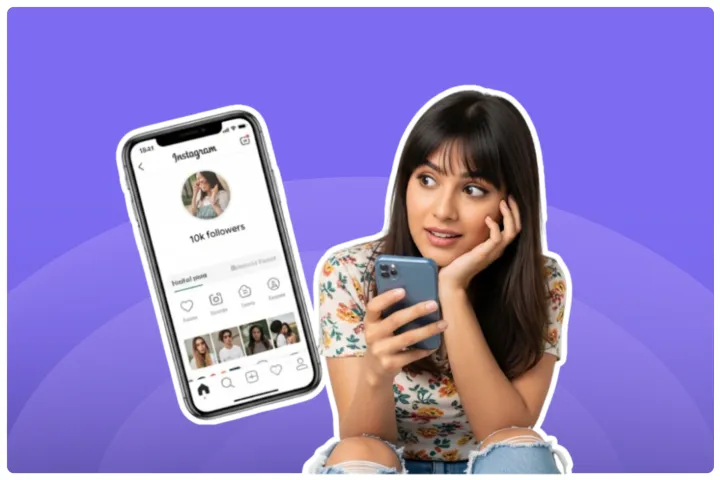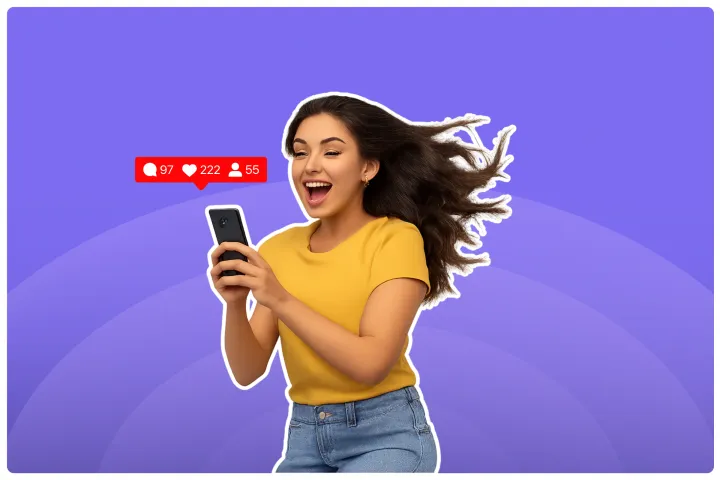How To Trace A Fake Instagram Account? (2025)
Wondering how to trace a fake Instagram account? Check out our guide for quick tips to identify impostors and keep your influencer marketing campaigns safe!
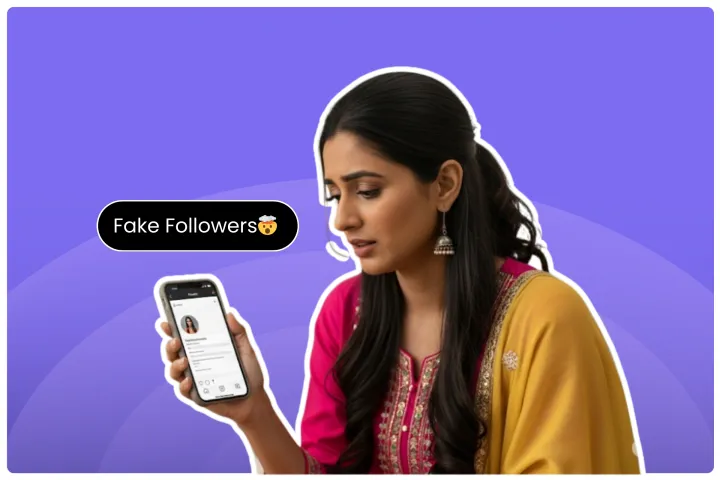
Running a business is demanding, and you pour your heart, soul, and hard-earned money into making it succeed. The last thing you need is to invest your marketing budget—whether it's ₹10,000 or ₹10,00,000—into an influencer campaign, only to find out you've been collaborating with someone whose audience is mostly bots or inactive accounts. Ouch! 😩 That not only wastes money but can also damage your brand's reputation if you're associated with inauthentic practices.
This guide will walk you through everything you need to know, from understanding what these fake accounts look like to using smart methods to trace them, and finally, leveraging powerful platforms like ryme.ai to connect with authentic influencers seamlessly.
Understanding Fake Instagram Accounts
First things first, what exactly are fake Instagram accounts in the context of influencer marketing? Simply put, these are profiles created with fraudulent intent. Their main goal is usually to deceive brands like yours into believing they have a large, engaged following, thereby securing paid collaborations they don't deserve. They aren't interested in genuine connection or community building; they're often just shells designed to look influential.
Think about it – genuine influence comes from trust and authenticity. Real influencers build communities around shared interests, create valuable content, and foster real conversations. Fake accounts, on the other hand, shortcut this process, often using shady tactics like buying followers or using automation to mimic engagement. They might use stolen identities, rely heavily on bots, or simply exist as empty profiles.
Understanding the different types of fake accounts can help you recognize them more easily. Let’s break down the common culprits:
Common Types of Fake Instagram Accounts
1) Impersonation Accounts:
These are perhaps the most malicious type. They deliberately mimic real individuals—sometimes well-known celebrities or established influencers, other times ordinary people—or even legitimate brands. They might steal profile pictures, copy bios, and even repost content from the original account to appear legitimate.
Why they're harmful: They can scam followers, spread misinformation, damage the reputation of the person or brand being impersonated, and trick businesses into fraudulent collaborations. Imagine collaborating with an account you think is a popular lifestyle influencer, only to find out it's a copycat profile with no real reach! Yikes.
Example: Someone creating an account like "@RealSneakerDeals" that looks very similar to a legitimate sneaker review account "@RealSneakerDeals", using a slightly altered logo and reposting their content initially to gain followers, then switching to promoting counterfeit goods or phishing links.
2) Bot Accounts:
These are automated profiles run by software, not humans. Bots are programmed to perform actions like following accounts, liking posts, and sometimes even leaving generic comments ("Nice pic!", "Great post! 👍"). Their primary purpose is often to inflate follower counts or engagement metrics for other accounts (including fake influencer accounts that buy their services).
Why they're harmful: While individual bots might seem harmless, large numbers of them create a false sense of popularity and engagement around an account. A profile might boast 100,000 followers, but if 70% are bots, their actual reach to real people is tiny.
Collaborating with such an account means your message reaches very few genuine potential customers. Studies from 2023 suggested a significant portion of interactions on major platforms could originate from automated accounts, highlighting the scale of the issue.
Example: An account suddenly gaining 10,000 followers overnight, and when you check those new followers, many have random alphanumeric usernames (e.g., @user83hd93k), no profile picture, zero posts, and follow thousands of accounts but have few followers themselves.
3) Ghost Accounts (or Inactive Followers):
These are accounts created by real people (initially, at least) but are now largely inactive. The user might have abandoned the platform, forgotten their password, or simply stopped engaging. Some ghost accounts might also be remnants of follower-buying schemes, where real-looking (but inactive) accounts were purchased.
Why they're harmful: Like bots, ghost accounts inflate follower numbers without providing any real value or engagement. They don't see posts, click links, or buy products. An influencer might have a high follower count, but if a large percentage are ghosts, their engagement rate (likes, comments, shares relative to follower count) will be suspiciously low. This means your campaign won't reach an active, interested audience.
Example: An influencer has 50k followers, but their posts consistently get only 100-200 likes and a handful of comments. This low engagement rate suggests many of their followers are inactive or uninterested – essentially 'ghosts' in their audience.
Understanding these types is the first step. Now, let’s look at the specific warning signs these accounts often display.
Red Flags of Fake Influencer Accounts
Okay, imagine you're scrolling through potential influencers for your next campaign. Their profiles might look glossy at first glance, but dig a little deeper, and you might start noticing things that just don't add up. Being aware of these red flags can save you a lot of headaches (and budget!). Think of yourself as a detective 🕵️♀️ looking for clues:
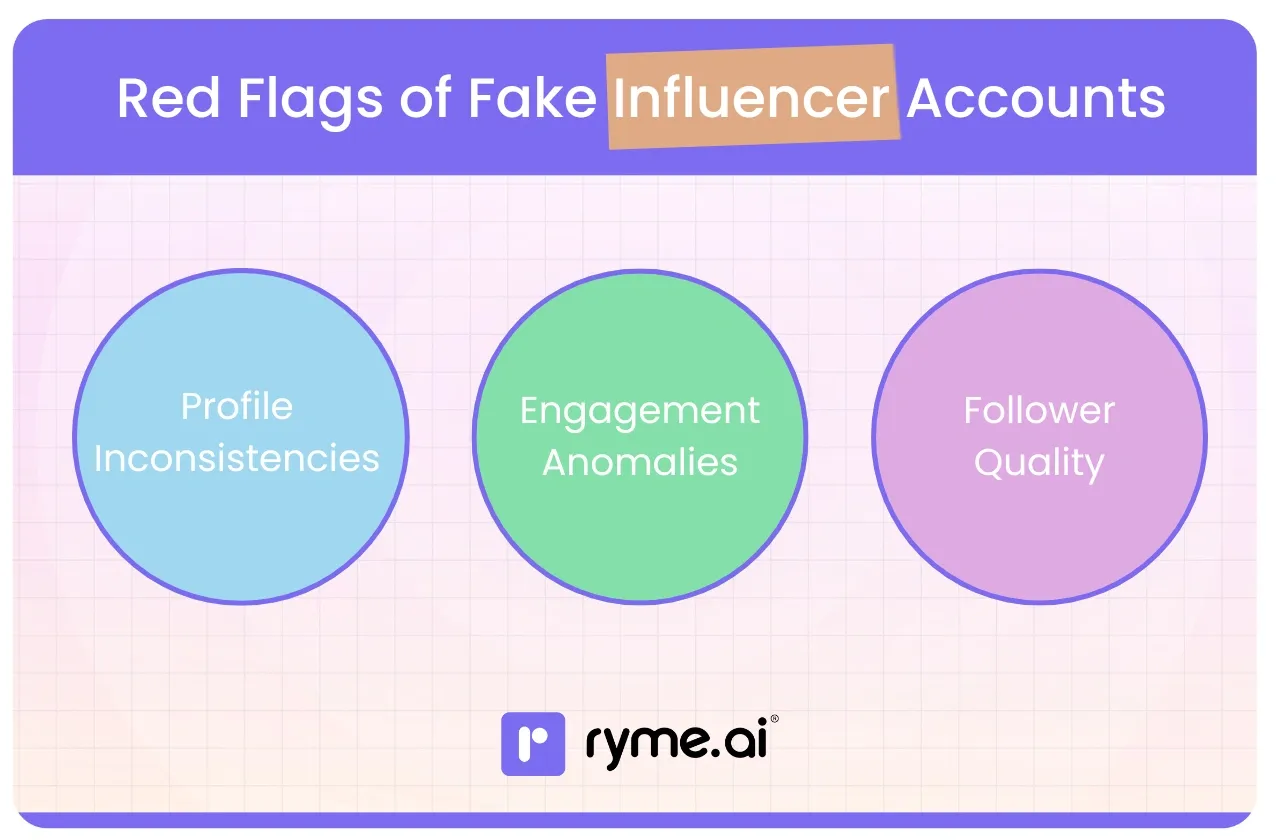
1) Profile Inconsistencies
Genuine influencers usually put effort into their profiles. It's their personal brand hub! Fake accounts often lack this polish and consistency.
Lack of Personal Information or Vague Bios:
Red Flag: The bio is super generic ("Lover of life | Fashion | Travel"), provides no real insight into who they are, has no link to a blog/website, or lacks contact information (or uses a suspicious-looking email).
Real influencers typically treat their bio as prime real estate to explain their niche, showcase their personality, and provide clear ways to connect or collaborate.
What to look for: A clear description of their niche or focus (e.g., "Mumbai Food Blogger," "DIY Craft Tutorials," "Sustainable Fashion Advocate"). Links to other platforms, a blog, or a portfolio. A professional contact email address. A touch of personality!
Example: A supposed travel influencer's bio just says "Wanderlust". Their posts show stunning locations, but there's no story, no personal reflection, just generic captions. Where are they really from? How do they afford constant travel? A lack of personal touch can be suspicious.
Inconsistent Posting Patterns:
Red Flag: The account posts in sudden bursts after long periods of silence. Or, they post dozens of photos all at once, maybe on the same day they gained thousands of followers (often a sign they just set up the fake profile). The content itself might be inconsistent – switching wildly between topics, image quality, or styles without any clear theme. Maybe lots of stock photos or reposted viral videos with no original content.
What to look for: A relatively consistent posting schedule (whether it's daily, weekly, or a few times a week). A cohesive theme or style in their content. A mix of content types (photos, Reels, Stories) that feels natural. Original content that reflects their stated niche.
Example: An account claiming to be a fitness influencer posts 30 workout photos on a single day, then nothing for two months, then another burst of generic fitness memes. Real influencers usually maintain a more regular content rhythm to keep their audience engaged.
2) Engagement Anomalies
Engagement (likes, comments, shares, saves) is the lifeblood of influencer marketing. Fake accounts often have metrics that just don't make sense.
High Follower Count with Low Engagement Rates:
Red Flag: This is one of the biggest giveaways. An account has 200,000 followers, but their posts only get 300 likes and 10 comments. That's an engagement rate of roughly 0.15% (Likes+Comments / Followers * 100).
Healthy engagement rates vary by niche and platform changes, but generally, rates consistently below 1% for macro-influencers, or even 2-3% for smaller, niche influencers, can be suspicious. It strongly suggests many followers are fake or inactive (bots/ghosts). Research from analytics firms in 2023-2024 consistently showed a correlation between low engagement rates and high percentages of suspicious followers.
What to look for: Engagement rates that feel proportionate to the follower count. For micro-influencers (say, 5k-20k followers), you might expect higher engagement (maybe 3-6%+). For larger accounts (100k+), 1-3% is more common. Look for consistency across posts.
Example: You find a "fashion influencer" with 500k followers. Sounds impressive! But then you check their last 10 posts. Likes per post hover around 1,000. That's only 0.2% engagement. Big red flag! 🚩 A real influencer with that following would likely have significantly more interaction.
Generic or Irrelevant Comments:
Red Flag: Scroll through the comments section. Do you see a lot of generic comments like "Nice!", "Great shot!", "Wow!", "Amazing!", or just strings of emojis (🔥🔥🔥, 🙌🙌🙌)? Are many comments completely unrelated to the post's content? This is a classic sign of bot activity or 'comment pods' where users agree to leave generic comments on each other's posts to inflate engagement artificially.
What to look for: Thoughtful comments that relate specifically to the photo or video. Questions from followers. Conversations happening between the influencer and their audience. Comments that show genuine reaction or add value.
Example: A food blogger posts a detailed recipe for Paneer Butter Masala. The comment section is filled with: "Cool pic," "Love it," "🔥🔥🔥," "Check out my profile!". Barely anyone mentions the recipe or asks a question about cooking it. This suggests low-quality engagement.
3) Follower Quality
Who is actually following this account? A quick scan can be revealing.
Presence of Ghost Followers or Bots:
Red Flag: Take a peek at their follower list (if their profile is public). Do you see a lot of accounts with no profile picture? Weird, random usernames (like lisa_83hdk9_ or _johnsmith123456789_)? Profiles with 0 posts, following thousands of people, but having very few followers themselves? These are strong indicators of bot or ghost accounts. While every account has a few, a large proportion is suspicious.
What to look for: Followers who look like real people – with profile pictures, posts, reasonable following/follower ratios, and usernames that look genuine.
Example: You spot-check 50 followers of a potential influencer. 30 of them have no profile pic, random names, and zero posts. This suggests a significant chunk of their audience isn't real.
Rapid, Unnatural Growth in Follower Count:
Red Flag: Did the account gain tens of thousands of followers seemingly overnight or in a very short period? While viral posts can cause growth spurts, extremely rapid and consistent growth without corresponding viral content often indicates followers were purchased. You can sometimes use third-party analytics tools (we'll discuss these later) to check follower growth history.
What to look for: Generally steady, organic growth over time. Spikes might happen with viral content or successful campaigns, but they should be explainable and usually accompanied by increased engagement.
Example: An account hovered around 5,000 followers for months, then suddenly jumped to 55,000 followers within a week, without any obvious viral post or major press mention. This pattern screams "bought followers."
Being aware of these red flags is your first line of defense. Don't rely on follower count alone! Always dig deeper and look at the quality of the profile, engagement, and followers. If something feels off, it probably is. Trust your instincts, but also use the methods we'll discuss next to verify your suspicions.
How To Trace A Fake Instagram Account
Okay, so you've spotted some red flags, or maybe you just want to be extra thorough before committing your brand's budget. Good call! Luckily, there are several practical methods you can use to investigate a potentially fake Instagram account. Think of these as your detective toolkit 🛠️:
Method #1: Instagram's 'About This Account' Feature
This is a built-in Instagram feature designed to increase transparency, and it's often your quickest first check. It's super easy to use!
How to Access It:
- Go to the Instagram profile you want to check.
- Tap the three dots (...) in the top-right corner of their profile.
- Select "About This Account" from the menu that appears. (Note: This option is only available for accounts that meet certain criteria, often those with larger followings or that run ads, but it's increasingly common).

What Information It Provides:
- Date Joined: When the account was created. A very recent creation date for an account claiming years of experience or a huge following can be a red flag.
- Account Based In: The country where the account is primarily located. If an influencer claims to be based in Mumbai but the feature says "Based in Russia," that's a major inconsistency to investigate.
- Former Usernames: If the account has changed its username, previous ones will be listed here (usually for the past year). This is incredibly useful! An account might have changed its name to hide a shady past, previous scam associations, or a complete switch in niche that doesn't align with its current supposed identity.
- Accounts With Shared Followers: Sometimes, Instagram shows other accounts that share a significant number of followers, which might give clues about the audience quality or potential connections to other suspicious accounts.
How It Helps Detect Fakes:
- A recent join date contradicts claims of long-standing influence.
- A country mismatch raises questions about their identity and target audience relevance.
- Frequent or suspicious username changes can indicate attempts to rebrand after issues or to deceive users. For instance, an account that was previously named "@CryptoScamAlerts" suddenly changing to "@LuxuryLifestyleGuru" is highly suspicious.
Limitations: Not all accounts have this feature enabled. The information might be limited (e.g., only recent username changes). Savvy fraudsters might find ways around some aspects (like using VPNs to mask location, though Instagram's detection is getting better). It's a valuable starting point, but not the only check you should perform.
Method #2: Reverse Image Search
This technique helps you determine if the profile picture or images posted by the account have been stolen from elsewhere on the internet. Fake accounts often use pictures of models, stock photos, or images taken from other people's profiles.
How to Do It:
- Get the Image: Take a screenshot of the profile picture or save one of the images from their posts. For profile pictures, you might need to view their profile on a desktop browser to easily save or copy the image URL.
- Use a Reverse Image Search Tool: Go to a tool like:
- Google Images (images.google.com): Click the camera icon in the search bar to upload the image or paste the image URL.
- TinEye (tineye.com): Upload the image or paste the image URL.
- Analyze the Results: The tool will search the web for visually similar images.
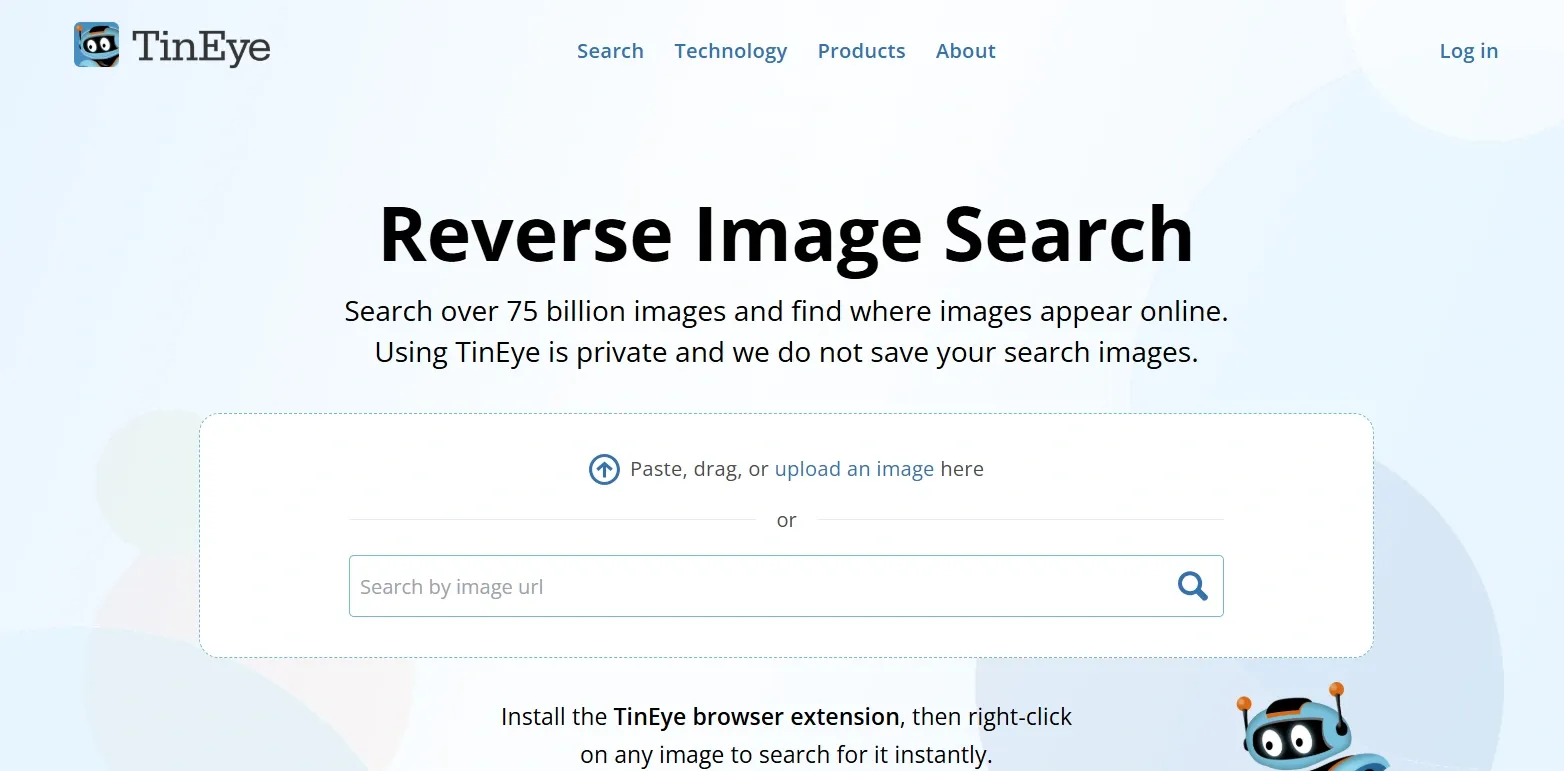
What the Results Tell You:
1) If the search results show the exact same image appearing on stock photo sites, other social media profiles (with different names/contexts), news articles, or websites unrelated to the influencer's claimed identity, it's a huge red flag. 🚩 It strongly suggests the image is stolen or misrepresented.
2) If the profile picture links back to a known model's portfolio or another person's active social media, the account is likely an impersonation or fake.
How It Helps Detect Fakes: It directly exposes the use of stolen or non-original imagery, which is a common tactic for fake profiles trying to build a believable facade quickly.
Limitations: May not work well for heavily edited photos or obscure images. Some influencers might occasionally use stock photos for certain types of posts (though their main content and profile picture should ideally be original). Private accounts prevent you from easily grabbing post images. It requires a bit of manual effort per image.
Method #3: Third-Party Analytics Tools
While manual checks are great, sometimes you need more firepower, especially for analyzing follower quality and engagement patterns at scale. Third-party tools are designed for this.
What They Do: These platforms connect to social media APIs (like Instagram's) or use sophisticated algorithms to analyze public data about influencer profiles. They can provide insights that are hard to gauge manually.
Types of Insights:
- Audience Authenticity: Estimating the percentage of followers that appear to be real people versus bots or inactive accounts. They look for patterns typical of fake accounts (as discussed in the 'Red Flags' section).
- Engagement Rate Analysis: Calculating true engagement rates and comparing them to benchmarks for similar accounts. Some tools can even analyze the quality of comments (spotting generic bot comments).
- Follower Growth Tracking: Showing historical follower growth, making it easy to spot sudden, suspicious spikes.
- Audience Demographics: Providing data on the location, age, gender, and interests of an influencer's audience (based on estimations). This helps verify if their audience aligns with your target market. A mismatch could indicate bought followers from irrelevant locations.
- Examples of Tools: There are various platforms available, ranging from free basic checks to comprehensive paid solutions. A prominent example focused on authentic connections is ryme.ai (which we'll explore in detail later). Other tools often mentioned in the industry include HypeAuditor, Social Blade, and Klear, each with different features and pricing.
How They Help Detect Fakes: These tools automate and deepen the analysis of follower quality and engagement. They can process large amounts of data quickly, providing scores or metrics that flag potentially fraudulent accounts much more efficiently than manual checks alone. Recent reports (2023-2024) highlight the increasing reliance on AI-powered analytics by brands to combat influencer fraud, which costs the industry billions globally each year.
Limitations: Accuracy can vary between tools and depends on the data they can access (Instagram's API restrictions can be a factor). Some tools require a subscription fee. Free versions often offer limited insights. Always use tool-based analysis as part of your overall assessment, but not as the sole deciding factor.
Method #4: Manual Profiling (The Deep Dive)
This method involves rolling up your sleeves and manually examining the account with a critical eye, combining insights from the red flags we discussed earlier. It complements the other methods.
What to Examine:
- Post Consistency and Quality: Go beyond just checking if they post. Look at the quality over time. Are the photos/videos consistently good, or are there sudden drops in quality? Does the content align with their claimed niche? Are they creating original content, or mostly reposting? Do older posts tell a consistent story with their current persona?
- Bio Clarity and Links: Revisit the bio. Does the link (if any) work? Does it lead to a professional-looking website or landing page, or something suspicious? Is the contact information functional?
- Comment Quality and Interaction: Don't just look at the number of comments; read them. Are people having real conversations? Does the influencer reply thoughtfully to comments, or just with generic "Thanks!" or emojis? Lack of genuine interaction can be telling. Check comments on sponsored posts too – are they engaged or just spam?
- Story Highlights and Activity: Check their Story Highlights (the circles below the bio). Do they showcase behind-the-scenes content, personal moments, or past campaigns that add credibility? Are they active on Stories regularly? (Though this is harder to track historically).
- Tagged Posts: Look at the posts they've been tagged in by other people (the tab with the person icon on their profile). Does this section show real interactions, collaborations, or event attendances? Or is it empty, or full of spam tags? Genuine influencers usually have tagged photos from events, friends, or brands they've worked with.
- How It Helps Detect Fakes: This manual deep dive helps you build a qualitative understanding of the account. It's about assessing the overall authenticity and genuineness that numbers alone can't always capture. Does this profile feel like a real person or brand with a real community?
Limitations: It's time-consuming, especially for analyzing multiple influencers. It can be subjective. Some fake accounts are becoming very sophisticated in mimicking real behavior.
Putting It All Together:
No single method is foolproof. The best approach is to use a combination:
- Start with a quick check using 'About This Account' (if available).
- Do a Reverse Image Search on the profile picture.
- Use a Third-Party Analytics Tool (like ryme.ai) for deeper insights into followers and engagement.
- Perform Manual Profiling to assess the qualitative aspects and look for inconsistencies.
- If an account raises multiple red flags across these checks, it's wise to steer clear. Your marketing efforts deserve genuine partners!
Instagram Fake Followers: Best Practices for Brands
Alright, you're now equipped with the knowledge to spot potential fakes. But how do you integrate this into your overall influencer marketing strategy? Simply identifying fakes isn't enough; you need proactive practices to ensure your brand consistently partners with authentic and effective influencers. Here are some best practices tailor-made for brands like yours:

1) Due Diligence is Non-Negotiable
Think of this as the foundational step for every single influencer collaboration, big or small. Don't skip it!
Always Verify Before Collaborating: Before you even reach out with a proposal, let alone sign a contract or send products/payment, thoroughly check the influencer's profile using the methods we discussed (About This Account, Reverse Image Search, Analytics Tools, Manual Profiling). Treat it like background checking a potential employee – because, in essence, they are representing your brand.
Look Beyond the Follower Count: Remember, vanity metrics can be deceiving. Focus on engagement rates, comment quality, audience demographics, and content relevance to your brand. Ask yourself: "Does this influencer reach the right audience for my product/service, and is that audience genuinely engaged?"
Check Past Collaborations: Look for previous sponsored posts (often marked with #ad, #sponsored, or "Paid partnership with..." tag). How did those perform? Did they generate real conversation? Did the influencer disclose the partnership clearly (which is also a legal requirement in many places)? You can sometimes even reach out to brands they've tagged to ask about their experience (though responses may vary).
Request a Media Kit (and Verify It): Most professional influencers have a media kit detailing their stats, audience demographics, past work, and rates. Request it! But don't take it purely at face value.
Cross-reference the stats they provide (like engagement rate, audience location) with what you observe directly on their profile and potentially through an analytics tool. Discrepancies are a red flag.
Consider a Small Test Campaign: For larger investments, you might consider starting with a smaller, lower-risk collaboration (e.g., a couple of Instagram Stories instead of a full Reel and post package) to gauge their professionalism, communication, and initial results before committing to a bigger campaign.
Why is this so crucial? Skipping due diligence can lead to:
- Wasted Budget: Paying for reach you never actually got. Imagine spending ₹50,000 on a campaign targeting young professionals in Delhi, only to find the influencer's audience was 60% bots and 30% based in Southeast Asia. That's money down the drain.
- Damaged Brand Reputation: Associating your brand with fraudulent accounts can harm your credibility. Customers are savvy and can often spot inauthenticity.
- Poor Campaign Results: Fake followers don't convert into customers. Your ROI will inevitably suffer.
2) Utilize Technology Wisely
Manual checking is essential, but it can be time-consuming, especially if you're managing multiple campaigns or exploring dozens of potential influencers. Technology can be your best friend here!
Leverage AI-Powered Platforms: Tools like ryme.ai are specifically designed to help brands navigate the complexities of influencer marketing. These platforms use Artificial Intelligence (AI) and Machine Learning (ML) to:
- Analyze Profiles at Scale: Quickly assess follower authenticity, engagement quality, and audience data for numerous profiles.
- Discover Relevant Influencers: Match your brand with influencers whose audience demographics, interests, and content genuinely align with your campaign goals, based on real data, not just guesswork.
- Detect Anomalies: AI algorithms are adept at spotting patterns indicative of fraud (like sudden follower spikes, bot-like comment activity) that might be missed by the human eye.
Integrate Analytics into Your Workflow: Don't just use tools for initial checking. Use them to track campaign performance in real-time, monitor influencer metrics during the collaboration, and measure the actual impact on your brand awareness, traffic, or sales. Platforms providing robust analytics (like ryme.ai using Meta API insights) give you reliable data for decision-making.
Think of it as an Investment: While some platforms have costs associated, view it as an investment in efficiency, accuracy, and risk mitigation. The cost of using a verification tool is often far less than the potential loss from collaborating with a single fraudulent influencer. A 2023 report by a cybersecurity firm estimated global losses due to influencer fraud in the billions of dollars annually – technology helps you avoid contributing to that statistic!
3) Continuous Monitoring is Key
Verification isn't just a one-time task you perform before signing a contract. The influencer landscape is fluid, and things can change.
Monitor During Campaigns: Once a campaign is live, keep an eye on the influencer's performance. Are they meeting the agreed-upon deliverables? How is the engagement on the sponsored content? Are the comments genuine, or does it look like they bought fake engagement specifically for your sponsored post? (Yes, that happens!). Address any concerns promptly and professionally.
Regularly Assess Long-Term Partners: If you have ongoing relationships with influencers, periodically re-evaluate their profiles. Have their engagement rates changed significantly? Has their audience demographic shifted? Have they maintained authenticity? A quick quarterly check-up using your preferred methods can ensure the partnership remains valuable.
Stay Updated on Platform Changes and Trends: Instagram algorithms and features change. New methods of fraud emerge, and new tools for detection become available. Stay informed about best practices in the influencer marketing industry. Follow reliable marketing news sources and communities.
Implementing these practices consistently will significantly reduce your risk of falling prey to fake influencers and help you build a strong, authentic, and high-ROI influencer marketing program. Remember, authenticity attracts authenticity! ✨
ryme.ai: Authentic Influencer Collaboration Platform
Now that we've covered the challenges of fake accounts and the best practices for finding genuine partners, let's talk about a specific solution designed to make this whole process easier, more efficient, and more reliable for brands like yours: ryme.ai.
Think of ryme.ai as your dedicated partner in navigating the influencer marketing space. It's not just another analytics tool; it's a comprehensive, AI-powered platform built specifically to connect brands with authentic influencers and streamline the entire collaboration workflow. If you're tired of the guesswork, the endless manual checking, or the high fees often associated with traditional agencies, ryme.ai could be the answer you've been looking for.
Overview: Your Go-To for Genuine Connections
At its core, ryme.ai is designed to tackle the very problems we've discussed: the prevalence of fake followers, the difficulty in finding truly relevant influencers, and the operational headaches of managing campaigns. It leverages the power of Artificial Intelligence to bring data-driven precision and efficiency to influencer marketing, making it more accessible and effective, especially for small to medium-sized brands (SMBs) and direct-to-consumer (D2C) businesses.
Imagine having a smart assistant that not only helps you find the perfect influencer match but also ensures they are genuine and helps manage the collaboration from start to finish. That's the vision behind ryme.ai.
Key Features: How ryme.ai Helps You Win
Let's break down some of the standout features and how they directly address the pain points brands face:
1) Zero Commission Model:
- The Problem: Traditional influencer marketing agencies often charge a hefty commission (anywhere from 15% to 30% or even more) on top of the influencer's fees. This can make influencer marketing prohibitively expensive, especially for brands with tighter budgets. Finding influencers directly can save on fees but requires significant time for vetting and management.
- ryme.ai's Solution: ryme.ai operates on a zero-commission model. This means you don't pay an extra percentage based on your campaign spend or the influencer's fees. Instead, access to the platform is typically based on a transparent subscription or a clear pricing structure.
- The Benefit for You: This makes influencer marketing significantly more cost-effective and predictable. You can allocate more of your budget directly to the influencers and the campaign itself, maximizing your ROI. For an Indian brand, saving that 20% commission on a ₹2,00,000 campaign means ₹40,000 stays in your pocket or can be reinvested into finding more influencers or boosting content! It levels the playing field, making powerful influencer marketing accessible even if you're not a corporate giant. 🥳
2) AI-Powered Matching:
The Problem: Manually searching Instagram using hashtags or keywords to find influencers is time-consuming and often relies on surface-level observations. It's hard to know if an influencer's actual audience truly matches your target customer profile or if their values align with your brand.
ryme.ai's Solution: The platform uses sophisticated AI algorithms to go beyond follower counts and aesthetics. It analyzes vast amounts of data, including:
- Content Analysis: Understanding the themes, topics, keywords, and sentiment of an influencer's posts.
- Audience Demographics: Analyzing follower data (location, age, gender, interests) to ensure alignment with your target market.
- Engagement Quality: Assessing the authenticity and relevance of likes, comments, and shares, flagging suspicious patterns.
- Brand Safety: Checking content for potentially harmful or off-brand material.
- Performance History: Looking at past campaign effectiveness where data is available.
The Benefit for You: You get matched with influencers who are not only authentic but also highly relevant to your specific niche, target audience, and brand values. No more shooting in the dark!
If you're selling handcrafted sarees to women aged 25-45 in metro cities, ryme.ai's AI can pinpoint influencers whose followers fit that precise description and whose content genuinely resonates with Indian ethnic wear enthusiasts. It's like having a data scientist dedicated to your influencer discovery. 🤓
3) Robust Analytics & Reporting:
The Problem: Measuring the true success of an influencer campaign can be tricky. Relying solely on the influencer's screenshots or basic Instagram insights might not give you the full picture, especially regarding authenticity and real impact.
ryme.ai's Solution: ryme.ai provides deep, real-time analytics and comprehensive reporting dashboards. Crucially, it leverages Meta API insights, meaning it pulls verified, direct data from Instagram (with appropriate permissions) wherever possible. This includes:
- Audience Authenticity Reports: Clear metrics on the estimated percentage of real vs. potentially fake followers.
- Engagement Tracking: Detailed breakdown of likes, comments, shares, saves, reach, and impressions for campaign content.
- Audience Demographic Verification: Confirming the influencer's audience data aligns with your targets.
- Campaign Performance Monitoring: Tracking key metrics throughout the campaign lifecycle.
- ROI Measurement: Features to help you connect campaign activities to tangible results like website traffic, conversions, or sales (integration capabilities may vary).
The Benefit for You: You can make informed decisions based on reliable data, not just vanity metrics. You can objectively assess influencer effectiveness, prove the ROI of your campaigns to stakeholders, and continuously optimize your strategy. Seeing real-time data means you can quickly identify if something isn't working as expected during a campaign and adjust course.
4) Streamlined Content Workflows:
The Problem: Managing influencer collaborations often involves messy communication chains – endless emails, DMs for approvals, tracking content submissions, ensuring timely posting, and handling payments. This administrative overhead can be a major drain on your time and resources.
ryme.ai's Solution: The platform acts as a central hub for managing the entire collaboration process:
- Communication: Built-in messaging features to communicate directly with influencers within the platform.
- Briefing: Tools to create clear campaign briefs outlining goals, deliverables, key messages, and guidelines.
- Content Approvals: Workflows for influencers to submit content drafts for your review and approval before posting.
- Scheduling & Tracking: Features to track content posting schedules and verify that deliverables are met.
- Payment Processing: Integrated or streamlined payment solutions to ensure influencers are paid securely and on time.
The Benefit for You: Massive improvement in efficiency! Reduce back-and-forth, minimize delays, ensure everyone is on the same page, and keep all campaign-related information organized in one place. This frees up your team to focus on strategy and results rather than getting bogged down in administrative tasks. It makes the collaboration smoother and more professional for both you and the influencer. 🙌
Why Choose a Platform Like ryme.ai?
In today's competitive market, leveraging technology like ryme.ai isn't just a nice-to-have; it's becoming a strategic necessity for brands that want to succeed with influencer marketing. It helps you to:
- Save Time and Money: By automating discovery, checking, and management, and avoiding costly mistakes with fake influencers.
- Reduce Risk: By ensuring you partner with authentic creators who won't damage your brand reputation.
- Improve Effectiveness: By connecting you with the right influencers whose audiences genuinely match your targets.
- Measure Real ROI: By providing reliable data to track performance and justify your marketing spend.
If you're serious about building authentic relationships with influencers and driving real results for your brand, exploring a platform like ryme.ai is a smart next step.
Conclusion
Whew! We've covered a lot of ground, haven't we? From understanding the sneaky ways fake accounts operate to learning practical methods for spotting them and implementing best practices for your brand. The main takeaway? While fake influencers and followers are definitely a challenge in the Instagram space, they are absolutely manageable with the right knowledge and tools.
Don't let the fear of fakes hold you back from exploring the incredible potential of influencer marketing. Instead, use the insights and strategies we've discussed to approach it smartly and confidently. You've got this!
Actionable Checklist & Key Takeaways
Feeling empowered? Here’s a quick checklist to keep handy as you navigate your influencer collaborations:
✅ Know the Fakes: Understand the difference between Impersonators, Bots, and Ghost Accounts.
✅ Spot the Red Flags:
- Check for Profile Inconsistencies (vague bio, weird posting schedule).
- Analyze Engagement Anomalies (high followers/low likes/comments, generic comments).
- Assess Follower Quality (look for bots/ghosts, unnatural growth spikes).
✅ Use Your Toolkit to Trace:
- Always check Instagram's "About This Account" feature (if available). Note Date Joined, Location, Former Usernames.
- Perform a Reverse Image Search (Google Images, TinEye) on profile pics & key posts.
- Utilize Third-Party Analytics Tools (like ryme.ai) for deep dives into audience authenticity and engagement metrics.
- Conduct Manual Profiling (check content quality, bio links, comment conversations, tagged posts).
✅ Implement Brand Best Practices:
- Due Diligence First: Verify every potential influencer before collaborating. Request and verify media kits.
- Leverage Technology: Use AI-powered platforms (like ryme.ai) for efficient discovery, checking, and campaign management.
- Monitor Continuously: Track performance during campaigns and periodically re-evaluate long-term partners.
✅ Focus on Authenticity & Fit: Prioritize genuine engagement and audience relevance over raw follower numbers.
✅ Consider a Platform like ryme.ai: Explore how tools offering zero commission, AI matching, robust analytics, and streamlined workflows can optimize your influencer marketing.


